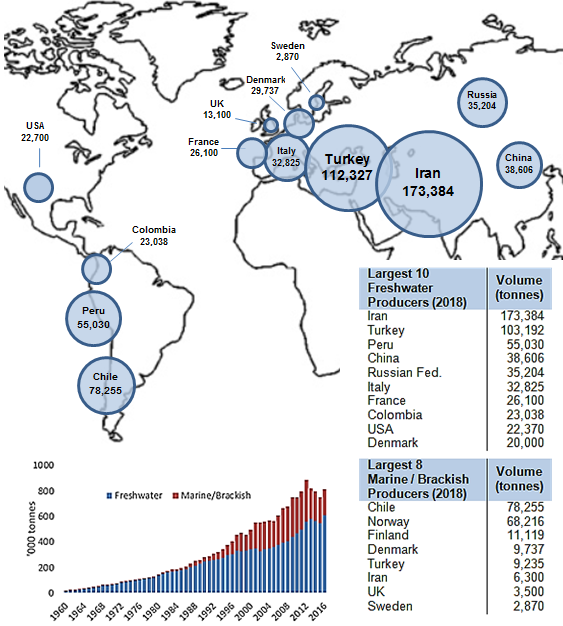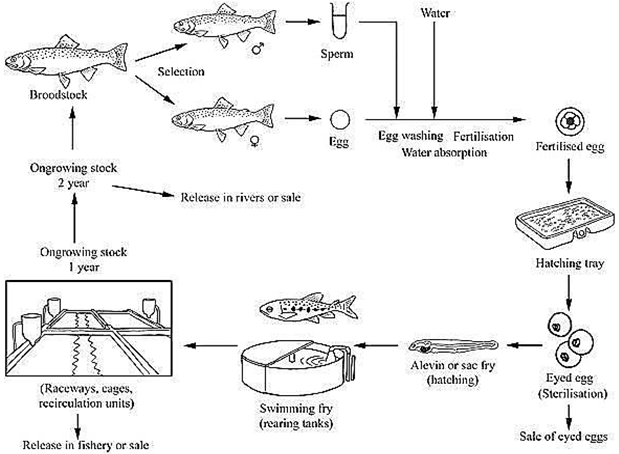Rainbow Trout
Oncorhynchus mykiss
Sources, Quantities and Cultivation Methods
Sources and Quantities
Rainbow trout are named so because of the iridescent pink band along the fish's flank1. The species was originally classified as Salmo gairdneri within the same family as Atlantic salmon and brown trout (Salmo trutta, also known as ‘sea trout’). However, in 1989 the species was reclassified as Oncorhynchus mykiss, and grouped with the Pacific salmons (pink, sockeye, chinook, etc.), reflecting its North America origin2. Like brown trout, rainbow trout may remain in freshwater throughout their life, or migrate to sea before returning to spawn. The migratory strain of rainbow trout is known as ‘steelhead’ in North America3.
Rainbow trout has been cultured since the late 19th century1, making it one of the species with longest presence in modern aquaculture4. As a result, it is often considered domesticated, having been selectively bred for many generations5. Rainbow trout have been spread globally for farming and angling, and are now present in eastern North America, Europe, South America, Africa, Asia and Australasia6. Because of its temperate origins and optimum temperature for farming of below 21°C1, in low latitude countries it is usually farmed in mountainous regions6.
Commercial rainbow trout farming took off in the 1950s in Denmark3, 4, heralding the global growth of aquaculture. It has been termed “the farmers’ fish”3 due to ease of breeding, feeding, fast growth, tolerance for a wide range of environmental conditions and handling1, 7. Rainbow trout can be farmed in a variety of systems, in both freshwater (FW) and seawater. In addition to being grown for consumption, the fish are valued for their sporting quality and farmed trout are commonly stocked into closed waters for angling1.
Rainbow trout are harvested year-round at both portion size (400 g) and large (1.5-5 kg) sizes1, 7. The species is valued as an ‘oily fish’ due to high omega 3 content of the flesh7. In addition to being retailed fresh, fillets of rainbow trout (usually large size) can be smoked, similar to salmon filets. Trout harvested in the UK typically have pink flesh, whereas both white- and pink-flesh fish are produced in other parts of the world1, 7. Salted trout eggs are sold as a form of caviar, especially in northern Europe7.
The global production of farmed rainbow trout has increased from 4,400 tonnes in 1950, to some 848,051 tonnes from over 70 countries, in 2018. The bulk of this production was from FW systems (77%), with the remainder from net-pens located in marine and brackish waters8.

In the last two decades, most of the growth in rainbow trout aquaculture FW production in Iran and Turkey. These two countries accounted for 42% of the total amount of rainbow trout produced in FW in 2018. In turn, Norway and Chile were the leading producers of marine-grown trout, benefiting from sharing production technology with the well-established Atlantic salmon farming industry in those countries. The UK is the 14th largest producer of rainbow trout, with almost 27% of its harvest coming from marine net-pens8.
Domestic Market Information
Our domestic seafood market is complex mix of products from wild caught and farmed species, including trout.
To discover more about the highly dynamic and ever-changing UK and Great British (GB) seafood marketplace, you can explore our user friendly and interactive Trade and Tariff in Tableau (T4) online tool. And visiting our dedicated Insight and Research pages will provide you with access to a wealth of information, from reports to factsheets on markets including:
- Retail – data from independent and multiple retailers in the UK used to reveal the latest insights on seafood eaten at home
- Foodservice – data from the foodservice industry in the UK used to highlight the latest trends on seafood eaten out of home
- Market supply – HM Revenue and Customs (HMRC) data used to detail what species and products are imported from, and exported to, the UK
To get the latest seafood market performance and trends delivered to your inbox, register at the Market Insight Portal.
Production Method1, 7
Rainbow trout will mature but not spawn naturally under farm conditions, so broodstock are “stripped” of eggs and milt which are then mixed. In order to either delay or prevent sexual maturation of fish destined for our tables, and thus avoid associated health, welfare and flesh quality issues, two techniques are used: ‘all-female’ and ‘triploid’.
- All-female: female trout mature at a larger size than male fish. In order to obtain only female fish, eggs from normal female broodstock are fertilized with the milt from physically male broodstock that are genetically female, having been sex-reversed when fry by addition of male hormones to their feed. All the progeny therefore only have female chromosomes.
- Triploid: stripped eggs are exposed to a ‘pressure shock’ which effectively doubles the number of maternal chromosomes. When fertilised by the male’s milt, the progeny have three sets of chromosomes instead of two, which results in sterility.
Such chromosome manipulations are not classed as genetic modification (or genetic alteration) as there is no deletion or insertion of DNA, and the processes could happen naturally. Chromosome manipulation has the additional benefit of preventing reproduction, should fish escape into the wild. Today, almost no mixed sex rainbow trout are farmed in Scotland, with all-female and triploid fish constituting 84% and 10% of production respectively9.
The almost universal application of chromosome manipulation techniques, coupled with selective breeding for desired traits such as growth rate, disease resistance and flesh quality, means that most rainbow eggs are now produced at centralised specialist broodstock sites. Eggs are then transported to hatcheries. For example, in Scotland, 92% of rainbow trout eggs in 2017 were imported - from Northern Ireland, Denmark, USA, Norway and the Isle of Man9.

Eggs are incubated in the dark at a stable temperature, typically in FW flow-through troughs. When they hatch the alevin lie on the trough bottom whilst absorbing their yolk-sac. Once the yolk-sac is exhausted they “swim-up” into the water column to feed. They are then fed formulated feeds, increasing in size from a crumb to larger pellets as they grow. The fish are moved from the hatchery to larger outdoor tanks and raceways of the nursery. Further growing-out to harvest continues outdoors in larger tanks, raceways and Danish (earthen) ponds. Fish can also be reared in floating net-pens in FW lakes/lochs. Farmed fish are graded (usually four times) to reduce size variation which aids stock management. The grow-out phase to portion size (400g) takes about 9 months.
Rainbow trout require high-quality water. FW supplies for hatcheries and nurseries are often sourced from springs or groundwater as these are clean, pathogen free and temperature stable. Grow-out units typically divert water from rivers or lakes, using land gradients to ensure adequate flow. The flow-through of water provides the fish with a current to swim against, supplies oxygen and removes wastes (e.g. solid particles of faeces, uneaten food, dissolved products of metabolism such as ammonia and carbon dioxide). Most farms have systems to reduce waste discharge, e.g. settlement ponds before final discharge back to the environment.
FW rainbow trout are commonly produced in intensive flow-through monoculture systems. FW resources are often limited, and flow-through farms typically reuse water by passing it through successive units (e.g. ponds or tanks). Where water is reused, water treatment, e.g. aeration, oxygenation, filtration, is often in place between units. However, farm water can also be recirculated, and some Danish trout farms have been converted from flow-through to re-circulation, but this requires significant investment to enable effective water management and treatment.
Rainbow trout are also grown-out in seawater in floating net-pens akin those used for salmon. Rainbow trout do not go through the “smolt” development stage of salmon, and the physiological ability to cope with a transfer to seawater is based upon size. Farms growing rainbow trout in seawater benefit from higher growth rate, with fish transferred at around 70 g reaching 3 kg in less than 1.5 years.
Rainbow trout are considered an efficient species to farm. The high-quality formulated feeds available and good feeding practices enable efficient use of feed resources, with food conversion ratios (food weight: fish weight increase) as low as 0.8:1. They are farmed at higher densities than brown trout and Atlantic salmon, up to 80 kg/m3, reflecting a high system productivity10, 11.
References
- FAO
- Smith GR, Sterly RF. 1989. The classification and scientific names of rainbow and cutthroat trouts. Fisheries. 14, 4-10.
- Sedgwick, DS. 1995. Trout farming handbook, 6th edition. Fishing News Books, Oxford, 164p.
- Gall, G.A.E, Crandell, P.A. 1992). The rainbow trout. Aquaculture. 100, 1-10.
- Donaldson, L.R., Olson, P.R. 1957. Development of rainbow trout brood stock by selective breeding. Transactions of the American Fisheries Society 85, 93-101.
- MacCrimmon, HR. 1971. World distribution of rainbow trout (Salmo gairdneri). Journal of the Fisheries Research Board of Canada. 28, 663-704.
- EC
- FAO FishstatJ
- Marine Scotland
- North, B.P., Ellis, T., Turnbull, J.F., Davis, J., Bromage, N.R. 2006. Stocking density practices of commercial UK rainbow trout farms. Aquaculture. 259, 260–267
- Ellis, T., North, B., Scott, A.P., Bromage, N.R., Porter, M., Gadd, D. 2002. The relationships between stocking density and the welfare of farmed rainbow trout. Journal of Fish Biology. 61, 493-531.